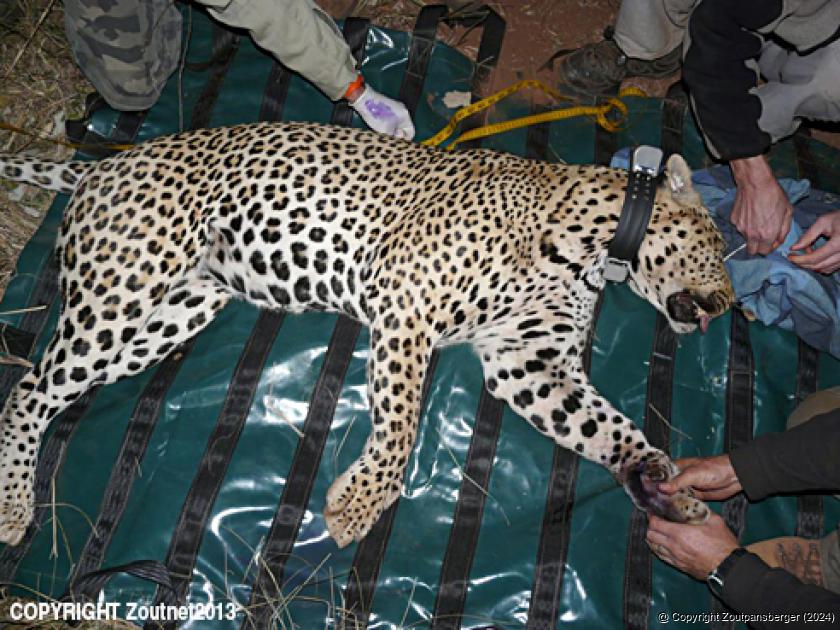

ADVERTISEMENT:

High mortality rate of leopards disturbing
Date: 19 April 2013 By: Andries van Zyl
With the Soutpansberg Mountains being home to an amazing array of species, a group of students is at present researching the enormous threats that primates, such as the samango monkey, and predators, such as the leopard, are facing from humans.
These animals are being studied by a team of scientists from the Durham University's Primate and Predator Project, which is based at the Lajuma Research Centre in the western Soutpansberg Mountains.
“We hope to gain a better understanding of the ways in which predators and prey interact with one another, using leopards and primates in the Soutpansberg as a model system. We are also interested in determining what kind of pressure these populations are under, for example assessing the level of human-wildlife conflict, and looking for ways to minimise these problems. Finally, we are also determining just how important this area is in terms of mammalian biodiversity,” says Dr Sam Williams, research coordinator of the project.
Williams explains that the Soutpansberg is one of the few places where all five species of non-human primates that occur in South Africa can be found living together. Researchers from the project follow samango monkeys through the forest to determine what governs their movement patterns. They want to learn how monkeys balance finding food with avoiding to become a meal themselves. The researchers also follow baboons to find out how the social behaviour of young animals develops as they grow up as this may shed some light on the evolution of social behaviour in humans. Some of the baboons have been fitted with collars that record their location and communicate with collars on leopards, in order to record interaction between the species.
In mid-2012, the project collared three adult leopards that were resident around Lajuma. The collars record the animals’ locations, using the global positioning system, which allows the scientists to map out their home ranges and see what happens when the leopards leave the safety of the mountains and venture onto agricultural land. By December 2012, two of the three leopards had been killed by humans – one was shot for hunting cattle and the other was snared, probably accidently, in traps that may have been set for catching bush pigs.
“This high level of mortality illustrates the extreme challenges facing both leopards and farmers. The Primate and Predator Project is dedicated to finding solutions to the conflict which will benefit both parties,” says Williams.
The researchers are now fitting additional collars to leopards to get a better idea of the scale of this problem. Camera trapping is also used to monitor predator populations and prey availability across a large area. This research is combined with scat analysis to understand predator diets and to determine the extent that domesticated animals feature in leopard and brown hyena diets.
The Primate and Predator Project would like to thank the landowners that allow them access to their land, and the abattoirs in Makhado (Louis Trichardt) for providing bait for predator trapping. Funding has been generously provided by the Earthwatch Institute, Durham University, Lajuma Research Centre and a number of private donors. More information about the project can be found on their website, http://www.dur.ac.uk/r.a.hill/primate_and_predator_project.htm. Residents can also email the project at [email protected].
Viewed: 916
|
|
Tweet |

-

Bestuurder hardloop weg na hy deur heining bars
25 April 2024 By Karla van Zyl -

Soutpansberg athletes conquer Two Oceans Ultra Martahon
25 April 2024 By Karla van Zyl -

MMSEZ now also looking at nuclear power
19 April 2024 By Andries van Zyl -

Woede ná R524 nog ‘n lewe eis
19 April 2024 By Andries van Zyl -

T20-spanne hervat liga ná kort breek
19 April 2024 By Andries van Zyl

Andries van Zyl
Andries joined the Zoutpansberger and Limpopo Mirror in April 1993 as a darkroom assistant. Within a couple of months he moved over to the production side of the newspaper and eventually doubled as a reporter. In 1995 he left the newspaper group and travelled overseas for a couple of months. In 1996, Andries rejoined the Zoutpansberger as a reporter. In August 2002, he was appointed as News Editor of the Zoutpansberger, a position he holds until today.

More photos...
 The researchers also follow baboons to find out how the social behaviour of young animals develops as they grow up as this may shed some light on the evolution of social behaviour in humans. Some of the baboons have been fitted with collars that record their location and communicate with collars on leopards, in order to record interaction between the species. Photo supplied.
The researchers also follow baboons to find out how the social behaviour of young animals develops as they grow up as this may shed some light on the evolution of social behaviour in humans. Some of the baboons have been fitted with collars that record their location and communicate with collars on leopards, in order to record interaction between the species. Photo supplied. 
ADVERTISEMENT


-

Former Triegie’s acting career taking off
12 April 2024 By Karla van Zyl -

Local para-athletes shine at SA Champs
05 April 2024 -

MMSEZ now also looking at nuclear power
19 April 2024 By Andries van Zyl -

Epic finish for local cycling duo
29 March 2024 By Andries van Zyl -

Debt-collection company apologises for rude letter
29 March 2024 By Anton van Zyl

ADVERTISEMENT:


ADVERTISEMENT


